How to Fix Three Common Backstroke Mistakes
Problems with your stroke can sap your speed or lead to injury
Whether you’re a serious backstroker or just use the stroke to recover from the butterfly leg of the individual medley, you should understand that several movements must come together at once to make your backstroke work efficiently.
With the combination of rotating your arms opposite each other, rotating your hips and core in sync with your arms, keeping your head in line with your spine, and kicking, there are many possible mistakes any swimmer can make. What you need to remember is that all swimmers at every level make stroke mistakes, and there are multiple ways to fix them.
Here are three common backstroke mistakes and ways to fix them.
Mistake No. 1: Crossing Over on Entry
One of the most common backstroke mistakes is crossing over the midline on entry. This slows you down because your hands must push water outward before catching the water and driving it toward your feet. This can affect your shoulders, core, and kick. Crossing over can also lead to impingement of rotator cuff muscles and subsequent injury.
How to Fix It
The OK Drill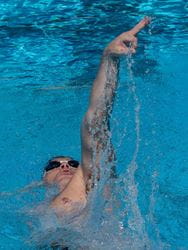
A good drill to keep you from crossing over is the OK drill. While you’re swimming, make the OK sign with your hands by touching the tips of your pointer fingers and thumbs together and keeping the other three fingers straight.
Doing this drill makes you think about your arm and hand position more because it can make crossing over painful. When you drill with your fingers in this position, it’ll also help you remember to throw your pinky finger into the water first, which sets up your catch. Always try to remember to press your belly button to your spine to hold your core in line.
Many swimmers who cross over their midlines are doing so with the backs of their hands splashing in first rather than their pinky fingers. Keeping your fingers in this OK position throughout the drill will help you catch more water with your forearm, so you’re not just using your hand as a paddle.
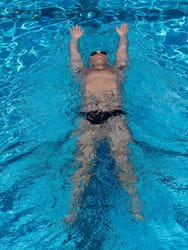 Think of a Clock
Think of a Clock
If you cross over, you’ll want to think of “10 and 2” (on an analog clock) and aim your pinkies to land on those numbers with a straight arm recovery (i.e., your right hand goes in at 2 o’clock and your left hand goes in at 10 o’clock).
If the 10 and 2 focus doesn’t help, think of 9 and 3. Although you’re not likely to throw your hands in at those actual locations for more than a few lengths, the more you aim for that, the closer you’ll be to obtaining that 11 and 1 position, which will bring you better results with your catch and slowly eliminate your crossover.
The Tantrum Drill
Think for a minute about that wild child in the grocery store who doesn’t get what he wants and proceeds to have a tantrum complete with arm throwing and leg kicking. Now translate that to throwing one arm and then the other backward in circles over and over as fast as you can. Try this on land first to get a feel for the rhythm.
Your shoulders need to rotate with your hands at the very end of the whole movement. You should realize very quickly that when you throw your arms backward fast like this that they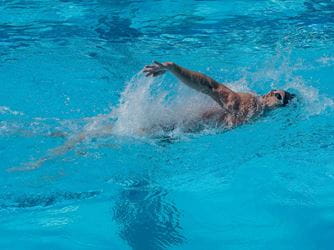 can’t help but go extra wide naturally to keep everything feeling good and your shoulders happy.
can’t help but go extra wide naturally to keep everything feeling good and your shoulders happy.
Do 10 extra-fast “tantrum” rotations (or just count to 10) as fast as you can with your arms. This will stop most of you well before you get to the other side of a 25-yard pool. Once you return to the wall, rest and then do another 25 of this drill, concentrating on staying as wide as possible and making sure your pinky goes in first.
After a few rounds of 25s doing the tantrum drill, slow down and keep thinking about the proper entry point. Catch the water with one arm and push back and use that momentum to throw the other arm to get it into the catch position.
This drill is also very helpful for swimmers who over-rotate and end up with a crossover kick.
Mistake No. 2: Improper Head Position
High head position can lead to bent knees and an inefficient kick. A high head position is far more common than you’d think, even among great backstrokers. When your head is too high, your hips are too low, your kick is out of place, and your arms and core don’t properly rotate. From the side, you’ll look like you’re sitting in a chair in the water.
How to Fix It
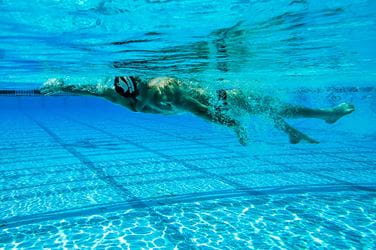
Exaggeration
A simple fix for a high head is to exaggerate the press of your shoulders and upper back into the water while relaxing your head back until the water is coming over your goggles. Once you’ve taken a few strokes like that, tuck your chin a little bit and keep your head relaxed in a position with your head on top of your spine, as though you’re “standing up straight.” Allow your body to stretch and rotate around your long axis while keeping a little more than half of your head in the water.
If you don’t wear a cap, you should feel the water line on the very center of the top of your head, or even a little closer to your forehead. Now swim a 25 looking down at your feet, then follow with a 25 with your shoulders and head pressed gently back in the water. This will help you feel both the incorrect and correct positions.
Mistake No. 3: Lack of Body Rotation
A lack of rotation could lead to you throwing water up and out of the pool with a catch that’s far too shallow. If you’re too f lat in the water, you aren’t rotating enough, and you may put your arms in an actual 9 and 3 o’clock position, which is too wide.
How to Fix It
Six-Kick, Three-Stroke Drill
To perform this drill properly, you need to get used to kicking on your side. If you’re doing this drill on your right side, your right arm should be extended behind you with your right hand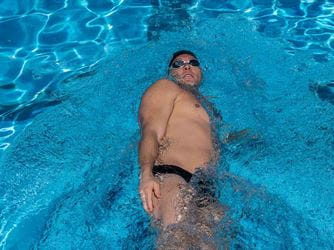 about 6 inches under the water, your left shoulder should be rotated to right underneath your chin, and your left arm should be resting against the side of your body with your fingers touching your thigh. Your kick should be small and quick and stay in line with the rest of your body. Splaying your legs will take you out of alignment. (Fins can help you get the proper body position, especially if you don’t have a strong kick.)
about 6 inches under the water, your left shoulder should be rotated to right underneath your chin, and your left arm should be resting against the side of your body with your fingers touching your thigh. Your kick should be small and quick and stay in line with the rest of your body. Splaying your legs will take you out of alignment. (Fins can help you get the proper body position, especially if you don’t have a strong kick.)
Once you’re used to kicking on each side, add your stroke. Take six kicks on one side, then one stroke, then six kicks on the other side. Do this for a few lengths. This really helps you get your hands and arms in a good position to grab the water a bit deeper than before.
Once you’ve mastered that, go to six kicks and three strokes, which puts you on the opposite side each time you switch from strokes to kicking. When you’re kicking, make sure you’re on your side, with the bottom arm stretched over your head and the top shoulder out of the water. Your elbow should bend after your body rolls so that your arm and hand have already entered at 11 and 1 or 10 and 2, which places your hand in the proper position to start the catch.
Categories:
- Technique and Training

















